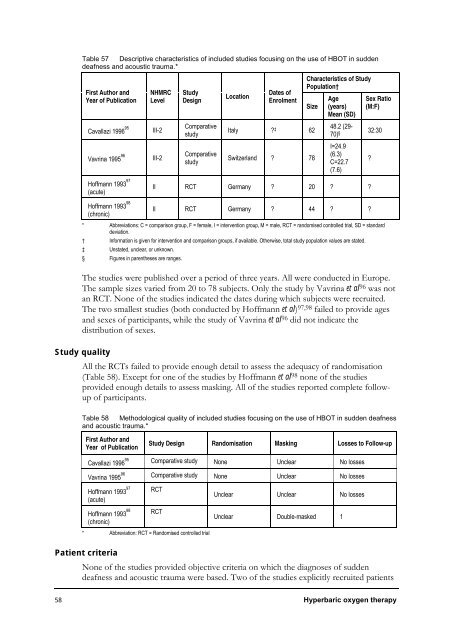Hyperbaric Oxygen Therapy - Hyperbaric Chamber Information ...
Hyperbaric Oxygen Therapy - Hyperbaric Chamber Information ...
Hyperbaric Oxygen Therapy - Hyperbaric Chamber Information ...
You also want an ePaper? Increase the reach of your titles
YUMPU automatically turns print PDFs into web optimized ePapers that Google loves.
Table 57 Descriptive characteristics of included studies focusing on the use of HBOT in sudden<br />
deafness and acoustic trauma.*<br />
First Author and<br />
Year of Publication<br />
Cavallazi 1996 95<br />
Vavrina 1995 96<br />
Hoffmann 1993 97<br />
(acute)<br />
Hoffmann 1993 98<br />
(chronic)<br />
NHMRC<br />
Level<br />
III-2<br />
III-2<br />
Study<br />
Design<br />
Comparative<br />
study<br />
Comparative<br />
study<br />
Location<br />
Dates of<br />
Enrolment<br />
Characteristics of Study<br />
Population†<br />
58 <strong>Hyperbaric</strong> oxygen therapy<br />
Size<br />
Italy ? ‡ 62<br />
Switzerland ? 78<br />
Age<br />
(years)<br />
Mean (SD)<br />
48.2 (29-<br />
70) §<br />
I=24.9<br />
(6.3)<br />
C=22.7<br />
(7.6)<br />
II RCT Germany ? 20 ? ?<br />
II RCT Germany ? 44 ? ?<br />
Sex Ratio<br />
(M:F)<br />
* Abbreviations: C = comparison group, F = female, I = intervention group, M = male, RCT = randomised controlled trial, SD = standard<br />
deviation.<br />
† <strong>Information</strong> is given for intervention and comparison groups, if available. Otherwise, total study population values are stated.<br />
‡ Unstated, unclear, or unknown.<br />
§ Figures in parentheses are ranges.<br />
The studies were published over a period of three years. All were conducted in Europe.<br />
The sample sizes varied from 20 to 78 subjects. Only the study by Vavrina et al 96 was not<br />
an RCT. None of the studies indicated the dates during which subjects were recruited.<br />
The two smallest studies (both conducted by Hoffmann et al) 97,98 failed to provide ages<br />
and sexes of participants, while the study of Vavrina et al 96 did not indicate the<br />
distribution of sexes.<br />
Study quality<br />
All the RCTs failed to provide enough detail to assess the adequacy of randomisation<br />
(Table 58). Except for one of the studies by Hoffmann et al98 none of the studies<br />
provided enough details to assess masking. All of the studies reported complete followup<br />
of participants.<br />
Table 58 Methodological quality of included studies focusing on the use of HBOT in sudden deafness<br />
and acoustic trauma.*<br />
First Author and<br />
Year of Publication<br />
32:30<br />
Study Design Randomisation Masking Losses to Follow-up<br />
Cavallazi 1996 95 Comparative study None Unclear No losses<br />
Vavrina 1995 96 Comparative study None Unclear No losses<br />
Hoffmann 1993 97<br />
(acute)<br />
Hoffmann 1993 98<br />
(chronic)<br />
RCT<br />
RCT<br />
* Abbreviation: RCT = Randomised controlled trial<br />
Unclear Unclear No losses<br />
Unclear Double-masked 1<br />
Patient criteria<br />
None of the studies provided objective criteria on which the diagnoses of sudden<br />
deafness and acoustic trauma were based. Two of the studies explicitly recruited patients<br />
?



